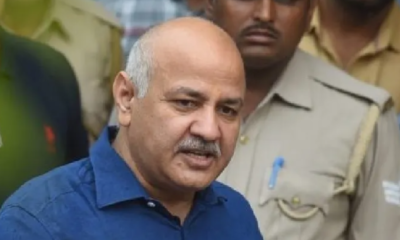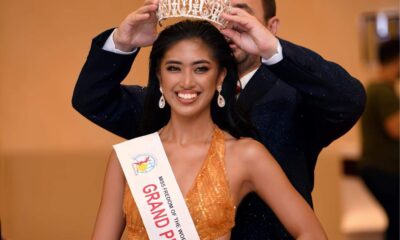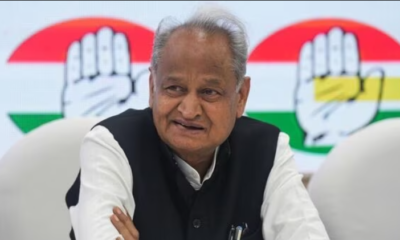Education
Korea’s Study Korea 300K Project: Attracting Global Students and Strengthening India-Korea Ties – Flaunt Post

In a rapidly globalizing world, international education has become a cornerstone of fostering cross-cultural understanding, driving economic growth, and enhancing a nation’s global competitiveness. Recognising the importance of this, the Republic of Korea (ROK) has set a lofty goal to welcome 300,000 international students to its colleges by 2027 through the “Study Korea 300K Project.” This bold project intends to support Korea’s higher education system while simultaneously providing a trained labour force for the country’s expanding high-tech sectors.
As 2023 marks the 50th anniversary of the friendship between India and Korea, it’s noteworthy that Indian students are increasingly considering Korea as a promising destination for overseas education. The two nations’ diplomatic ties have been strengthened by the rising use of the Korean language in India and considerable academic, technological, and cultural exchange partnerships. Minister Lim Sang Woo emphasises that Korea, historically an education-focused country, has made academic collaborations with India a key priority.
The crucial role that education had in Korea’s development is highlighted by the fact that it went from being a war-torn nation to one of the top ten economies in the world. The Study Korea 300K Project, which aims to revolutionise the entrance for overseas students and establish Korea as a global education powerhouse, is built on this history.
The project involves a comprehensive set of strategies to achieve its goal. Key among them is the revision of visa policies, including permanent residency, to address Korea’s low birth rate and aging population, which is fueling the demand for international workers and students. The streamlined visa process, especially for Indians proficient in the Korean language, is designed to meet the urgent workforce needs of Korean IT, technology, and automobile companies.
Under the Regional Innovation System & Education (RISE) programme, universities, local businesses, and government agencies work together to address regional needs and develop domestic opportunities for Indian companies. This is in line with the overarching goal of fostering foreign employees with specialised skills, particularly in industries like fabrication, machinery, and welding.
Korean language schools are opening across the country in order to help international students adapt to Korean life and culture. Additionally, to increase accessibility for overseas students, the government is urging colleges to increase the number of English-language lectures.
In addition, the Departments of Science and Technology of India and the Republic of Korea have encouraged Indian and Korean scholars and scientists to submit proposals in a number of cutting-edge sectors. This cooperative research intends to promote innovation in fields such as renewable energy, semiconductors, quantum technologies, robotics, and green transportation, further strengthening the academic links between the two countries.
The growing popularity of K-pop and Korean dramas has fueled interest among young people in India in learning the language and experiencing Korean culture. With students choosing both online and offline sessions, initiatives like the inclusion of Korean as one of the eight foreign languages in secondary schools under India’s National Education Policy (NEP) 2020 have increased its reach.
Universities in Korea have improved their efforts to aid in the integration of Indian students. Courses and programmes in Korean language and studies are offered at universities like the University of Delhi (DU), Jamia Milia Islamia (JMI), Christ University, Manipur University, and Nalanda University. This academic alliance attempts to boost student enrollment in Korean colleges by offering generous scholarship opportunities.
The historical ties established via Buddhism have sparked academic and research collaborations between Korea and India. An MoU was recently signed by Dongguk University in Seoul with Nalanda University to advance Buddhist philosophy and research. Seoul National University established a Department of Asian Languages and Civilizations in 2012, offering a degree in Indian Studies. Several other South Korean universities provide courses in Indian Philosophy, Yoga, and Ayurveda.
The Study Korea 300K Project is evidence of Korea’s dedication to worldwide linkages, international education, and developing a skilled labour force for the future. As other countries also intensify efforts to attract international students, Korea’s proactive approach underscores its dedication to becoming a global education hub and a destination of choice for students seeking quality education, diverse experiences, and a gateway to the future. The relationship between India and Korea is expected to deepen via cooperation, innovation, and cultural exchange in the years to come, to the advantage of both countries and the students who undertake this fruitful educational trip.
Education
When Sean Penn Got Mad at Chris Rock: Recapping the 2005 Oscar Ceremony

Twenty years ago, the 77th Academy Awards delivered an unforgettable mix of glamour, controversy, and standout performances. It was a night where Million Dollar Baby took home Best Picture, Jamie Foxx solidified his status as a Hollywood favorite, and Beyoncé dominated the stage with three performances. But amidst all the usual Oscar glitz, one unexpected moment stood out: Sean Penn publicly taking issue with Chris Rock’s joke about Jude Law.
As the evening unfolded, Rock, known for his sharp comedic style, took aim at various celebrities while hosting the ceremony. One of his quips targeted Jude Law, poking fun at his seemingly ubiquitous presence in movies that year. While most stars in attendance laughed along, Penn, who had worked with Law on All the King’s Men, was not amused. When he took the stage to present an award, he veered off-script to defend Law’s talent, stating, “Jude Law is one of our finest actors.” The moment was a rare instance of an A-list actor directly calling out the host during the live broadcast, adding unexpected tension to the night’s festivities.
Beyond Penn’s impassioned defense, the 2005 Oscars were filled with memorable highlights. Hilary Swank won her second Best Actress award for Million Dollar Baby, further cementing her Hollywood legacy. Jamie Foxx’s heartfelt speech after winning Best Actor for Ray left many in the audience teary-eyed. Meanwhile, Beyoncé showcased her vocal prowess with multiple performances, making her mark as a powerhouse entertainer even outside the music industry.
Looking back, the night was emblematic of what makes the Oscars both unpredictable and fascinating—where scripted moments can be overshadowed by spontaneous drama. Two decades later, Sean Penn’s reaction to Chris Rock’s joke remains one of the more unusual yet talked-about moments in Oscar history.
Education
Indian TOEFL Test Takers Embrace Diverse Study Abroad Destinations – Flaunt Post

Indian students and professionals looking to study or work abroad have been expanding their destination options recently, signalling a substantial change in the international education environment. Traditional choices like the United States and Canada are experiencing competition from growing locations like Singapore, Australia, France, and Sweden, according to statistics published by the Educational Testing Service (ETS), which conducts the TOEFL exam. This change reflects the changing goals and motives of Indian test-takers.
Since 2017, the United States and Canada have held the top two spots as the most popular destinations for Indian TOEFL test takers. The third and fourth positions were held by Germany and the United Kingdom, respectively, until a significant shift in 2020 saw the UK overtake Germany for the third rank. This change emphasises how flexible options for overseas schooling are. While the top five destination countries have stayed largely unchanged over the previous few years, Sachin Jain, the Country Manager of ETS India and South Asia, asserts that these growing countries are gaining popularity among Indian test takers. This pattern reflects the evolving goals and driving forces of Indian professionals and students.
PTI’s exclusive access to data reveals interesting patterns in the test-takers’ motivations. From 5.83 percent of all test takers in 2021 to 7.77 percent in 2022, the proportion of Indian test takers planning to continue secondary education and certificates overseas has consistently gone up. In contrast, the percentage of people seeking immigration or employment has decreased, going from 8.19 percent to 7.22 percent over the same time period. The percentage of Indian exam takers in this category increased from 70.84 percent in 2021 to 71.87 percent in 2022, indicating a growing interest in graduate and postgraduate programmes overseas. This demonstrates how eager Indian students are to take advantage of opportunities for top-notch education on a global scale.
Notably, there has been a sharp rise in Indian test takers for the TOEFL. A startling growth of 53% over the prior year was seen in 2021, and this trend continued into 2022 with a growth of 59% over 2021. The TOEFL test has had significant participation in major Indian cities like New Delhi, Mumbai, Bengaluru, Pune, Hyderabad, Gurugram, Chennai, Kolkata, and Ahmedabad.
The TOEFL has most recently been approved as a valid language competency test under Canada’s Student Direct Stream (SDS), which is intended to speed up the processing of study permits for overseas students. This development is anticipated to increase the number of Indian exam takers even more, opening up a new pathway for Indians looking to enrol in Canadian universities. More than 12,000 colleges in more than 160 countries accept the TOEFL score. Over 98% of UK universities recognise its validity, and it is generally acknowledged in other popular study destinations like the United States, Canada, Australia, New Zealand, and the United Kingdom.
Data from the Education Ministry that were given in Parliament highlight the rising worldwide mobility of Indian students in search of chances for higher education. In 2022, the number of Indian students enrolling in higher education overseas exceeded 7.5 lakh, marking a six-year high. India will overtake China as the country that sends the most foreign students to the United States in 2022, highlighting this trend even further.
In conclusion, a changing environment in international education is reflected in the preferences and motives of Indian TOEFL test takers. Indian students and professionals are becoming more interested in emerging nations while still travelling to major conventional locations like the United States and Canada. As the world grows more interconnected, there are more options for Indian aspirants to consider when it comes to furthering their education and careers abroad.
Education
Timeless Classics: 10 Must-Read Masterpieces That Resonate Through the Ages – Flaunt Post

Literature has a great ability to take us through various times, locations, and viewpoints while providing a window into the human experience over the ages. There are few eternal classics in the huge world of literature that continue to enthral and speak to readers from all backgrounds. These works of literature have stood the test of time, and the themes and concepts they contain are just as relevant today as they were when they were first written. These classics have established themselves as must-reads in the world of literature, promising readers both enjoyment and enlightenment through epic adventures and profound philosophical thoughts.
- Pride and Prejudice (Jane Austen)
Austen’s masterpiece is a delightful blend of sharp wit, sparkling dialogue, and enduring themes. It’s a story that appeals to both your mind and heart, with its romance, expensive clothing, and biting societal satire.
- Frankenstein (Mary Shelley)
Mary Shelley’s groundbreaking science-fiction novel explores the consequences of tampering with life. It’s a story that remains relevant today as we grapple with the ethical dilemmas of technology.
- Orlando (Virginia Woolf)
Take a whimsical journey through centuries as you follow the enigmatic Orlando, who undergoes a transformation from a nobleman to a woman, exploring the fluidity of gender and love across time.
- Little Women (Louisa May Alcott)
This seemingly simple story about the lives of the four March sisters carries profound messages about personal growth, familial responsibilities, and societal expectations during the nineteenth century.
- Great Expectations (Charles Dickens)
Charles Dickens presents the captivating story of Pip, an orphan boy who rises from humble beginnings to a world of wealth and respectability, only to discover the true nature of happiness.
- The Time Machine (H.G. Wells)
H. G. Wells’ pioneering science-fiction novella introduces the concept of time travel and continues to inspire the imagination of writers and readers alike.
- Women of the Harlem Renaissance (Marissa Constantinou)
Explore topics including love, jazz, and Jim Crow legislation as you delve into the brilliant creativity of Black women during the Harlem Renaissance. In this outstanding collection, you’ll find voices from both well-known and obscure authors.
- Of Mice and Men (John Steinback)
This poignant tale revolves around two migrant friends, George and Lennie, and their dream of owning a piece of land despite the challenges they face.
- Madame Bovary (Gustave Flaubert)
A timeless examination of a woman’s ambitions and social limitations can be found in Gustave Flaubert’s moving depiction of Emma Bovary’s tribulations in a loveless marriage.
- One Hundred Years of Solitude (Gabriel Garcia Marquez)
This book, which is set in the made-up town of Macondo and features a compelling fusion of magic realism and social critique, follows the Buendia family through several generations.
These classic novels offer not only entertainment but also profound insights into the human experience. Whether you’re drawn to romance, science fiction, social commentary, or historical narratives, these timeless works have something to offer every reader. So, embark on a literary journey through these classics and discover the enduring relevance of these timeless tales.
-

 Featured2 years ago
Featured2 years agoOnline Threats for Jewish Students in Cornell University – Flaunt Post
-

 Featured2 years ago
Featured2 years agoSupreme Court Delays Verdict in Manish Sisodia’s Corruption Case, Legal Battle Continues – Flaunt Post
-

 Entertainment1 year ago
Entertainment1 year agoSamantha Gabronino, Katwalk Doll Queen, Wins Miss Freedom of the World Grand Prix Title
-

 Featured1 year ago
Featured1 year agoSerena Novikov: Modeling Success in the Digital World
-

 Sports2 years ago
Sports2 years agoWATCH: Virat Kohli Shakes A Leg On ‘Lungi Dance’ Song During India Vs Sri Lanka Asia Cup 2023 Super 4 Match
-

 Featured2 years ago
Featured2 years agoED’s “Red Rose” in Rajasthan: Political Turmoil Ahead of Assembly Elections – Flaunt Post
-

 Featured2 years ago
Featured2 years agoPDA Takes Center Stage: Akhilesh Yadav Hints at Independent Path Amidst Alliance Uncertainty – Flaunt Post
-

 Entertainment7 months ago
Entertainment7 months agoBillie Eilish: Redefining Music, Fashion, and Activism for a New Generation




